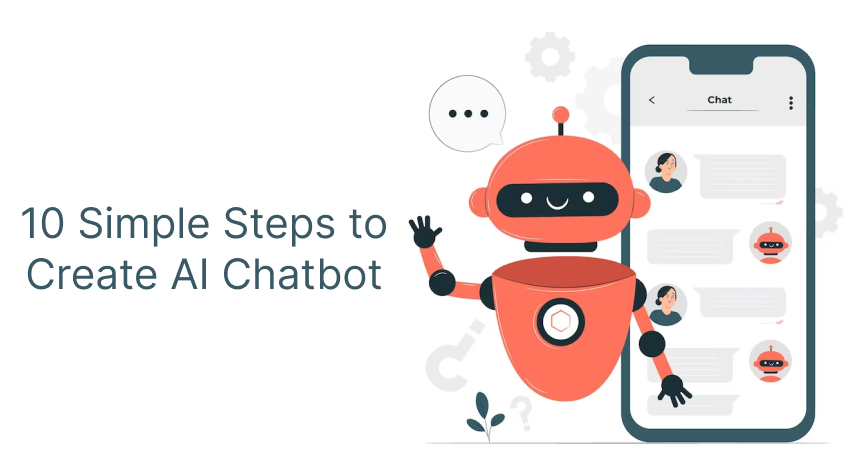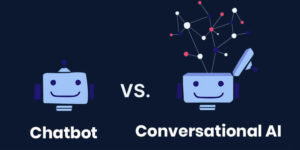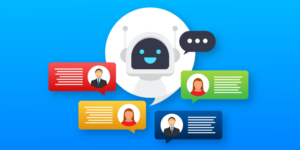
Create Chatbot have emerged as vital companions in the fast-paced, digital world of today. These clever computer programs, designed to engage in text or voice conversations, have become cornerstones of communication across various industries. Their significance is deeply rooted in their ability to elevate customer service and user experiences. By swiftly addressing queries, they cut down response times, paving the way for heightened customer satisfaction.
Beyond this, chatbots have woven their prowess into e-commerce, healthcare, banking, and customer support realms. They take on routine tasks with finesse, unravel frequently asked questions, and remarkably, even contribute to medical diagnostics. As technology progresses, chatbots are poised to shape how we interact with technology, streamlining our day-to-day interactions and experiences.
How to Build AI Chatbots from Scratch
Building AI chatbots from scratch requires a systematic approach and a combination of various technologies. Here’s a straightforward guide to get you started
- Define the Purpose: Identify the Chatbot’s purpose and intended audience to determine its scope and functionalities.
- Choose the Technology: Select the right development tools and programming languages based on your expertise and the complexity of the Chatbot.
- Gather Data: Collect and curate relevant data for training the Chatbot. This dataset will be essential for natural language understanding and generating suitable reactions.
- Implement Natural Language Processing (NLP): Use NLP libraries to accurately process and interpret user inputs. This helps the Chatbot to comprehend user intent and context.
- Train the AI Model: Employ machine learning algorithms to train the Chatbot’s AI model using the collected dataset. Continuously fine-tune the model to improve performance.
- Design Conversations: Create engaging and natural-sounding conversational scripts catering to the user’s needs and preferences.
- Integrate with APIs: Connect the Chatbot to external APIs and databases to provide real-time information and perform specific tasks.
- Test Thoroughly: Conduct extensive testing to identify and fix any bugs or issues, ensuring a seamless user experience.
- Deploy the Chatbot: Choose a platform to host your Chatbot, whether a website, messaging app or other communication channels.
- Monitor and Improve: Continuously monitor user interactions and feedback to make necessary improvements and improve the Chatbot’s overall performance.
Building AI chatbots from scratch requires dedication and continuous improvement, but it opens up possibilities for delivering efficient and personalized user experiences.
Comprehensive Guide to Build AI Chatbot
1. Understanding Chatbots
Chatbots are artificial intelligence (AI) applications designed to communicate with human users through text or voice interactions. They come in two main types: Rule-based and AI-driven chatbots.
Rule-based chatbots operate on predefined rules and replies programmed by developers. They follow a specific flowchart or decision tree to address user queries. While they can be simple to create and manage, their answers are limited and need more adaptability.
AI-driven chatbots, on the other hand, leverage advanced technologies like Natural Language Processing (NLP) and Machine Learning (ML). They can understand and interpret human language, allowing for more sophisticated and contextually relevant responses. AI-driven chatbots continuously learn from user interactions, becoming more accurate and personalized.
Chatbots’ applications span different industries that include customer support, e-commerce, healthcare, and finance. They provide 24/7 availability, faster response times, and cost-effectiveness, improving customer satisfaction and operational efficiency.
The key components of a chatbot include:
- Natural Language Processing (NLP): This allows the Chatbot to comprehend and process natural language inputs from users.
- Machine Learning (ML): The Chatbot can learn from data and user interactions, enhancing its responses and decision-making abilities.
- Dialog Management: Controls the flow of conversations, guaranteeing readable and contextually appropriate interactions.
- Intent Recognition: Identifies the user’s intent behind their message to generate relevant responses.
- Entity Recognition: Extracts specific information from user inputs, aiding personalized responses.
- APIs and Integrations: Enables the Chatbot to connect with external systems and databases to retrieve real-time information.
Combining these key components allows chatbots to offer more engaging and human-like interactions, revolutionizing how businesses and individuals communicate and access information.
2. Planning Your Chatbot
Creating a successful chatbot starts with a well-thought-out plan. Here are crucial steps in planning your Chatbot
- Identifying Purpose and Goals: Clearly define the purpose of your Chatbot and the specific goals you aim to achieve. A clear purpose will guide the development process, whether providing customer support, automating tasks, or generating leads.
- Defining Target Audience and User Personas: Understand your target audience’s requirements, choices, and pain points. Develop user personas representing different user types to tailor the Chatbot’s interactions and responses to their specific requirements.
- Choosing the Right Platform and Channels: Select the most suitable platform and communication channels for your Chatbot. It could be integrated into your website, deployed on popular messaging apps like WhatsApp or Facebook Messenger, or even accessible through social media platforms. Knowing where your audience consumes most of their time will ensure maximum engagement.
By carefully planning your Chatbot’s purpose, understanding your audience, and selecting the right platform, you’ll set a strong foundation for building an effective chatbot that delivers value to both your business and users.
3. Designing the Chatbot Conversations
Designing chatbot conversations that feel natural and engaging is crucial for user satisfaction. Here are some best methods to accomplish this
- Writing Conversational Scripts: Craft chatbot responses in a conversational tone that mimics human interactions. Use simple language, avoid jargon, and be friendly and empathetic in responses. Incorporate greetings, expressions of gratitude, and polite farewells to create a positive user experience.
- Creating a Natural User Experience: Design the Chatbot to follow a coherent and logical conversation flow. Offer options or suggestions to guide users through the interaction. Use step-by-step queries to elicit information and evade bothering users with too many inquiries.
- Handling User Inputs and Error Messages: Prepare the Chatbot for various user inputs, including typos, abbreviations, and synonyms. Implement fallback responses when the Chatbot doesn’t understand a query, providing helpful prompts or alternative options. Avoid generic error messages and offer clear explanations and steps to resolve issues.
By adhering to these best practices, your Chatbot will establish a seamless and enjoyable user experience, building trust and encouraging users to return for future interactions. Graceful handling of user inputs and errors will ensure the Chatbot remains helpful and user-friendly even in challenging situations.
4. Build Chatbot
Building your Chatbot requires carefully considering the development approach, selecting appropriate tools, and following a systematic process. Here’s a brief guide to get started
Choosing a Development Approach
- DIY: Building from scratch might be suitable if you have programming talents and want full control over the Chatbot’s functionalities. It offers flexibility but requires more time and expertise.
- Chatbot Development Framework: Existing frameworks like Dialogflow, Microsoft Bot Framework, or Rasa can expedite development. They offer pre-built components for NLP and dialog management, simplifying the process.
Overview of Popular Development Tools and Platforms
- Dialogflow: A Google-owned NLP platform with an intuitive interface, suitable for beginners and advanced developers.
- Microsoft Bot Framework: A comprehensive framework that supports multiple programming languages and integration with various channels.
- Rasa: An open-source framework for advanced developers, offering full customization and control over the Chatbot’s behavior.
Step-by-Step Guide to Building a Basic Chatbot Prototype
- Determine the objective and goals of your Chatbot.
- Identify user personas and create sample conversations.
- Select the development approach and platform.
- Design conversational flows and write scripts for interactions.
- Implement NLP components and train the Chatbot with relevant data.
- Test the prototype and gather user feedback with an AI form generator for improvements.
By following this guide, you can build a basic chatbot prototype that lays the foundation for a more sophisticated and efficient AI-driven chatbot in the future.
5. Advanced Chatbot Development
Advanced chatbot development involves enhancing user interactions and responses through advanced techniques
Implementing NLP and Sentiment Analysis
- NLP enables the Chatbot to understand and process user inputs more accurately, improving the quality of responses.
- Sentiment analysis allows the Chatbot to gauge user emotions and respond appropriately, enhancing user satisfaction.
Integrating AI and Machine Learning
- AI-driven chatbots leverage machine learning algorithms to learn from data, leading to more contextually relevant and personalized responses.
- Algorithms can recognize patterns in user behavior, adapt to new information, and continuously refine their capabilities.
Handling Context and User Session State
- Maintaining context throughout conversations enables the Chatbot to understand references and maintain a coherent interaction flow.
- Tracking the user session state ensures the Chatbot remembers previous interactions, preventing repetition and creating a smoother user experience.
These advanced techniques allow chatbots to provide more accurate, meaningful, and interactive conversations, increasing user engagement and satisfaction.
6. Making Your Chatbot Smarter
Elevating your Chatbot’s capabilities involves ongoing refinement and learning. Here’s how to make your Chatbot smarter
Data Collection and Analysis
- Regularly gather user interactions to improve the Chatbot’s understanding of language nuances and user intent.
- Analyze user queries and responses to identify trends, joint issues, and areas for enhancement.
Incorporating User Feedback and User Testing
- Act on user suggestions and feedback to address pain points and implement desired features.
- Conduct user testing to observe real interactions, uncover usability issues, and fine-tune the Chatbot’s performance.
Implementing Chatbot Analytics
- Integrate analytics tools to monitor the Chatbot’s usage patterns, engagement, and popular queries.
- Measure key performance metrics such as response accuracy, user satisfaction, and conversion rates.
By harnessing data insights, user input, and analytics, you empower your Chatbot to evolve continuously, delivering increasingly tailored and effective interactions.
7. Deploying Your Chatbot
Deploying your Chatbot successfully requires careful attention to various aspects
Platform Considerations
- Evaluate the nature of your audience and where they are most active. Choose platforms like websites, messaging apps (Facebook Messenger, WhatsApp), or business tools (Slack) accordingly.
- Ensure the Chatbot’s interface and functionality are optimized for the chosen platform’s requirements and limitations.
Security and Privacy
- Implement strong security standards to safeguard user data and prevent unauthorized access.
- Comply with data protection regulations (such as GDPR or CCPA) by clearly stating data usage policies and obtaining user consent.
Monitoring and Maintenance
- Continually observe the Chatbot’s performance, user interactions, and feedback to identify issues or opportunities for improvement.
- Regularly update the Chatbot’s content, responses, and functionalities to keep it relevant and effective.
Addressing these considerations ensures a smooth and secure deployment, fostering user trust and maximizing the Chatbot’s impact on your audience.
8. Chatbot Marketing and User Adoption
Effectively promoting your Chatbots for Marketing and encouraging user adoption requires a strategic approach
Strategies to Promote Your Chatbot
- Utilize social media, email newsletters, and your website to announce the launch of your Chatbot.
- Create engaging content that showcases the Chatbot’s value and benefits through videos, blog posts, and interactive demos.
- Recruit influencers or partners in your industry to help spread the word about your Chatbot.
Tips for Increasing User Adoption and Engagement
- Ensure the Chatbot’s onboarding process is user-friendly and intuitive, guiding users through their first interactions.
- Incorporate gamification features like quizzes, challenges, or rewards to make the experience interactive and pleasant.
- Regularly update the Chatbot’s content and responses to keep users engaged and provide fresh information.
By employing these strategies and adopting user-centric practices, you can effectively market your Chatbot and create a strong foundation for user adoption and engagement.
Future of Chatbots
The landscape of chatbots is evolving rapidly, driven by emerging trends and innovative advancements
Current Trends in Chatbot Development and Usage
- Multilingual Capabilities: Chatbots handle multiple languages proficiently, expanding their global reach and user base.
- Voice-Enabled Chatbots: Integrating voice recognition and generation, permitting users to interconnect with chatbots through voice commands.
- Omnichannel Integration: Chatbots seamlessly transition between platforms, providing consistent experiences across websites, apps, and messaging services.
Potential Advancements and Applications
- Hyper-Personalization: Chatbots will leverage AI to deliver highly personalized recommendations and solutions based on individual preferences.
- Emotional Intelligence: Chatbots could exhibit emotional understanding, recognize user sentiments, and respond empathetically.
- Complex Problem Solving: Advancements in AI will enable chatbots to handle intricate queries, contributing to fields like healthcare diagnosis or financial planning.
These trends and advancements indicate a promising future for chatbot technology, enriching user experiences and transforming industries through more sophisticated, intuitive, and versatile interactions.
Conclusion
In creating a chatbot, we’ve explored vital steps that lay the foundation for success. From identifying purposes, understanding audiences, choosing platforms to design conversations, implementing AI, and deploying smartly, each step is crucial. The future is promising, with enhanced personalization, emotional intelligence, and intricate problem-solving trends.
As you embark on your chatbot-building adventure, remember that technology is at your fingertips, waiting to be harnessed. The role of chatbots in reshaping customer interactions and AI advancement is undeniable. So, embrace the potential, start building, and be part of the transformative landscape shaping our digital future.






